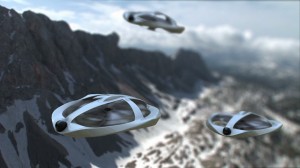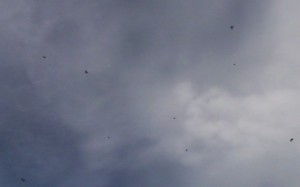UAVs have revolutionized the way countries and governments gather information and conduct reconnaissance, among many other things. No longer are we required to put boots on the ground in dangerous countries or have the Coast Guard venture into dangerous disaster areas to enact rescue missions. With the development of UAVs, controllable from vast distances, the need for human risk has diminished. However many UAVs are large, rendering them unable to maneuver through complex terrain or making them easy targets for anti-aircraft rockets. The natural solution of this lies not only in reducing their size and flight capability, but in mimicking a feature of animal flight and survival: flying in packs, or swarms. Small-scale UAVs functioning as swarms that rely upon one another, seen in nature in such actions as migrating birds, allows for much more sensitive data collection and less of an obvious presence to enemy combatants or targets, as well as complex navigation through difficult terrain.
Swarm-based UAVs have become a very popular research interest in the past five or so years. Numerous different groups, from defense to government to academic, have taken the concept of swarms and had much success with it. The ultimate goal of all of them is to make UAVs that can function as a group and act autonomously without the input of humans. Many developers have taken an approach of using “evolutionary” algorithms to allow for the swarm to continuously be updated as to their surroundings and their status, while keeping an updated map of their terrain. An example of this is the Smart Warfighting Array of Reconfigurable Modules (SWARM) UAV project, done by the Naval Surface Warfare Center. Their take on this was that if they were to have, for example, 100 small UAVs, and say a few of them malfunction or have other problems such as engine failure, the other UAVs will become aware of this and they will find a new formation that will allow the rest of the swarm to collect on the data the malfunctioning UAVs were supposed to be collecting. This allows the swarm to function as a hive mind of sorts, making decisions based on the good of the whole. The applications of these, once the technology is perfected, are limitless and extend to other mediums as well, from underwater exploration to outer space, and extreme environments such as the Arctic.
Boeing is one company who is developing a swarm-based technology. Based heavily on the communication systems used by animal swarms, their recent test included having the swarm search a test area and map it, also generating waypoints, and then sending this information back to a network. This technology was not used by mini UAVs, but rather large scale ones in order to test the success of the software.
However the military capabilities of this technology are not the limit of its development; the Ecole Polytechnique Federale de Lausanne in Switzerland is developing swarm software for use in disaster situations. Their Swarming Micro Air Vehicle Network (SMAVNET) is being designed as a communications relay in disaster situations to aid rescuers. These UAVs are true swarm-based mini-UAVs, weighing in at 420g each with a wingspan of 80cm. Their software uses a gyroscope along with two pressure sensors to make the decision of which flight path is better than another. Their communication abilities mimic that of army ants: army ants use pheromones to remember the path they take from the nest to food. The SMAVNET technology uses a similar principle to allow for the UAVs to paint a path based on remembrance so that it can have a constant communication path to the “home base” for sending information back.
The goal of achieving a truly intelligent, autonomous swarm of mini-UAVs is one that scientists have been knocking on the door of over the past year or so. The efforts have been highly successful as of now, and will only lead to more improvements over time. There are many different approaches that have been taken and have been successful, modeled on anything from using many sensors, evolutionary algorithms in the software, and pheromones for communication. But no matter the means, the ends justify the work put into this project. With swarm technology having applications in defense, disaster relief, search and rescue, and a whole host of other areas, mini-UAVs that can observe and react to their surroundings will change the lives of many around the world.
Sources:
“$20M to Develop UAV Swarm Technologies.” Defense Industry Daily. Watershed Publishing, 11 2005. Web. 5 Dec 2012. <http://www.defenseindustrydaily.com/20m-to-develop-uav-swarm-technologies-0496/>.
B., Damir. “Swarming UAVs could be used to save lives at sea.” RobAid. N.p., 12 2012. Web. 5 Dec 2012. <http://www.robaid.com/bionics/swarming-uavs-could-be-used-to-save-lives-at-sea.htm>.
Quick, Darren. “Boeing demonstrates swarm technology.” Gizmag. N.p., 22 2011. Web. 6 Dec 2012. <http://www.gizmag.com/uav-swarm-technology/19581/>.
Quick, Darren. “Aerial swarming robots to create communications networks for disaster relief.” Gizmag. N.p., 28 2010. Web. 4 Dec 2012. <http://www.gizmag.com/smavnet-robot-swarm/16499/>.
Rawley, Chris. “UAV Swarms Will Change Warfare Forever.” Information Dissemination. N.p., 1 2012. Web. 6 Dec 2012. <http://www.informationdissemination.net/2012/02/uav-swarms-will-change-warfare-forever.html>.
Thryft, Ann R. “Autonomous UAVs Fly in Swarms.” Blogs. DesignNews, 7 2012. Web. Web. 5 Dec. 2012. <http://www.designnews.com/author.asp?section_id=1386&doc_id=249665&dfpPParams=ht_13,industry_aero,industry_gov,aid_249665&dfpLayout=blog>.


